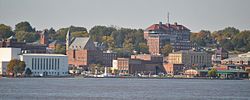Burlington, Iowa
|
Burlington, Iowa Shoquoquon Flint Hills |
|
|---|---|
| City | |

Skyline of Burlington from Mississippi River
|
|
 Location in the state of Iowa |
|
| Coordinates: 40°48′29″N 91°6′57″W / 40.80806°N 91.11583°WCoordinates: 40°48′29″N 91°6′57″W / 40.80806°N 91.11583°W | |
| Country | United States |
| State |
|
| County | Des Moines |
| Founded | 1833 |
| Government | |
| • Mayor | Shane McCampbell |
| • City Council | Becky Anderson (Mayor Pro Tem) Robert Fleming Tim Scott Becky Shockley |
| Area | |
| • Total | 15.24 sq mi (39.47 km2) |
| • Land | 14.48 sq mi (37.50 km2) |
| • Water | 0.76 sq mi (1.97 km2) |
| Elevation | 696 ft (185 m) |
| Population (2010) | |
| • Total | 25,663 |
| • Estimate (2012) | 25,665 |
| • Density | 1,772.3/sq mi (684.3/km2) |
| • Demonym | Burlingtonian |
| Time zone | CST (UTC-6) |
| • Summer (DST) | CDT (UTC-5) |
| ZIP code | 52601 |
| Area code(s) | 319 |
| FIPS code | 19-09550 |
| GNIS feature ID | 0454995 |
| Website | burlingtoniowa |
Burlington is a city and the county seat of Des Moines County, Iowa, United States. The population was 25,663 in the 2010 census, a decline from the 26,839 population in the 2000 census. Burlington is the center of a micropolitan area including West Burlington, Iowa, and Middletown, Iowa, and Gulfport, Illinois. Burlington is the home of Snake Alley, once labelled the crookedest alley in the world.
Prior to European settlement, the area was neutral territory for the Sac and Fox Indians, who called it Shoquoquon (Shok-ko-kon), meaning Flint Hills.
In 1803, President Thomas Jefferson organized two parties of explorers to map the Louisiana Purchase. The Lewis and Clark Expedition followed the Missouri River, while Lt. Zebulon Pike followed the Mississippi River. In 1805, Pike landed at the bluffs below Burlington and raised the United States Flag for the first time on what would become Iowa soil and recommended construction of a fort. The recommendation went unheeded.
The American Fur Company of John Jacob Astor established a post in the area in 1829. Settlement began in 1833, shortly after the Black Hawk Purchase, when Samuel (aka Simpson) White, Amzi Doolitle, and Morton M. McCarver crossed the Mississippi River from Big Island and staked claims there. According to an account A.T. Andreas wrote in 1875, White erected a cabin in the area later platted to be Front Street between Court and High streets. Andreas called White and Doolittle the Romulus and Remus of their settlement, referring to the mythic heroes who founded Rome, a city surrounded by hills. A few weeks later, William R. Ross joined them and established a general store. In November and December, he surveyed the settlement for White and Doolittle.
...
Wikipedia
